Case Study: Social and Legal Ramifications of Drug Use in Leavers Week
VerifiedAdded on 2020/10/05
|9
|2797
|143
Case Study
AI Summary
This case study examines the issue of substance abuse during Leavers Week, a post-high school celebration in Australia. It explores the social and legal ramifications of drug and alcohol consumption, including physical and mental health issues, social isolation, legal penalties, and the loss of human capital. The study contrasts two policy approaches: demand reduction and supply reduction, analyzing their effectiveness in addressing the problem. It also delves into the conceptual models of addiction, specifically the moral model, and discusses its implications. The case study highlights the negative impacts of substance abuse on individuals, communities, and tourism during Leavers Week, emphasizing the need for effective prevention and intervention strategies. The study concludes by examining the moral model of addiction and its associated consequences.

CASE STUDY
Paraphrase This Document
Need a fresh take? Get an instant paraphrase of this document with our AI Paraphraser

Table of Contents
INTRODUCTION...........................................................................................................................3
MAIN BODY...................................................................................................................................3
1. Social and legal ramifications face by young people for consuming drugs and alcohol........3
2. Compare and contrast of policy approaches ..........................................................................4
3. The conceptual model of addictions.......................................................................................6
CONCLUSION................................................................................................................................7
REFERENCES................................................................................................................................7
INTRODUCTION...........................................................................................................................3
MAIN BODY...................................................................................................................................3
1. Social and legal ramifications face by young people for consuming drugs and alcohol........3
2. Compare and contrast of policy approaches ..........................................................................4
3. The conceptual model of addictions.......................................................................................6
CONCLUSION................................................................................................................................7
REFERENCES................................................................................................................................7
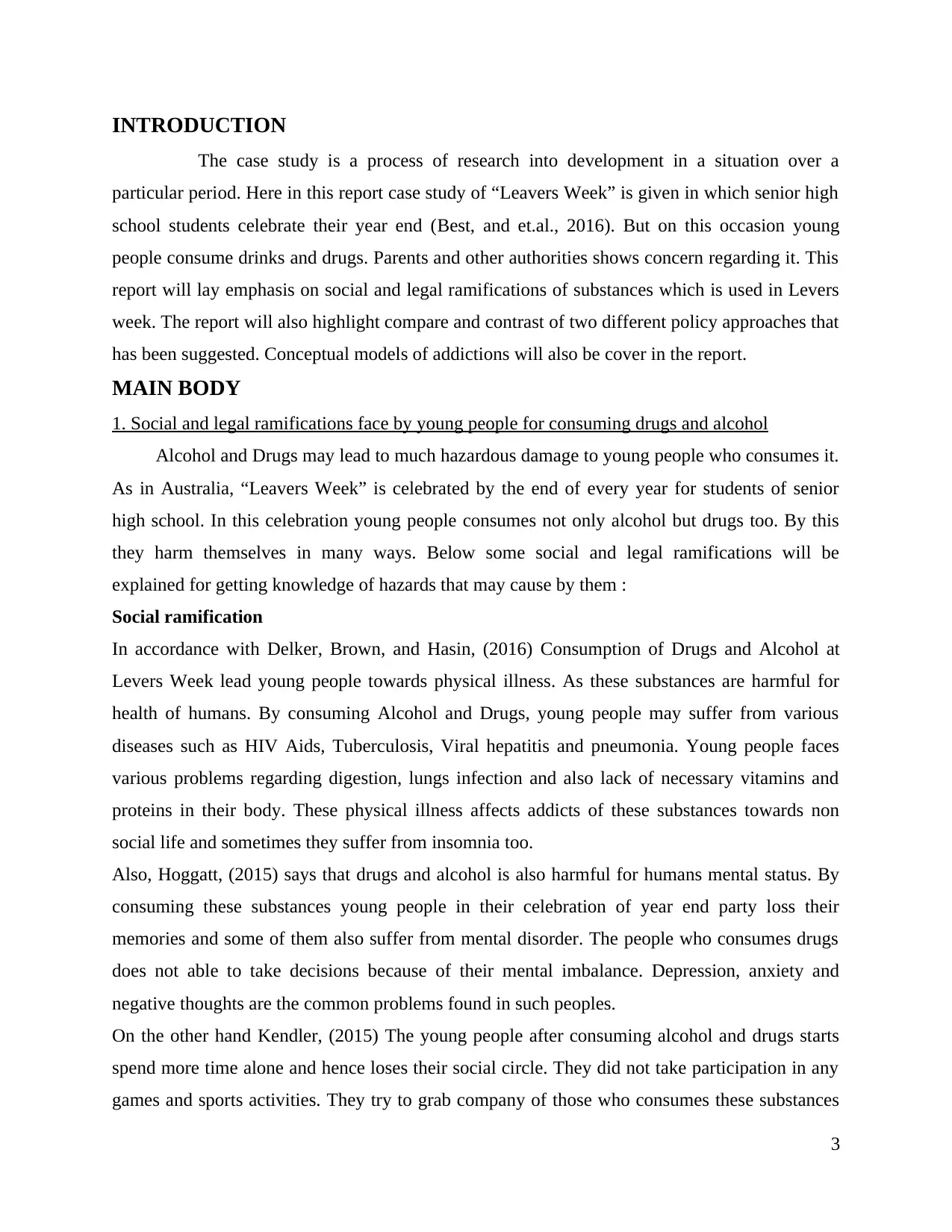
INTRODUCTION
The case study is a process of research into development in a situation over a
particular period. Here in this report case study of “Leavers Week” is given in which senior high
school students celebrate their year end (Best, and et.al., 2016). But on this occasion young
people consume drinks and drugs. Parents and other authorities shows concern regarding it. This
report will lay emphasis on social and legal ramifications of substances which is used in Levers
week. The report will also highlight compare and contrast of two different policy approaches that
has been suggested. Conceptual models of addictions will also be cover in the report.
MAIN BODY
1. Social and legal ramifications face by young people for consuming drugs and alcohol
Alcohol and Drugs may lead to much hazardous damage to young people who consumes it.
As in Australia, “Leavers Week” is celebrated by the end of every year for students of senior
high school. In this celebration young people consumes not only alcohol but drugs too. By this
they harm themselves in many ways. Below some social and legal ramifications will be
explained for getting knowledge of hazards that may cause by them :
Social ramification
In accordance with Delker, Brown, and Hasin, (2016) Consumption of Drugs and Alcohol at
Levers Week lead young people towards physical illness. As these substances are harmful for
health of humans. By consuming Alcohol and Drugs, young people may suffer from various
diseases such as HIV Aids, Tuberculosis, Viral hepatitis and pneumonia. Young people faces
various problems regarding digestion, lungs infection and also lack of necessary vitamins and
proteins in their body. These physical illness affects addicts of these substances towards non
social life and sometimes they suffer from insomnia too.
Also, Hoggatt, (2015) says that drugs and alcohol is also harmful for humans mental status. By
consuming these substances young people in their celebration of year end party loss their
memories and some of them also suffer from mental disorder. The people who consumes drugs
does not able to take decisions because of their mental imbalance. Depression, anxiety and
negative thoughts are the common problems found in such peoples.
On the other hand Kendler, (2015) The young people after consuming alcohol and drugs starts
spend more time alone and hence loses their social circle. They did not take participation in any
games and sports activities. They try to grab company of those who consumes these substances
3
The case study is a process of research into development in a situation over a
particular period. Here in this report case study of “Leavers Week” is given in which senior high
school students celebrate their year end (Best, and et.al., 2016). But on this occasion young
people consume drinks and drugs. Parents and other authorities shows concern regarding it. This
report will lay emphasis on social and legal ramifications of substances which is used in Levers
week. The report will also highlight compare and contrast of two different policy approaches that
has been suggested. Conceptual models of addictions will also be cover in the report.
MAIN BODY
1. Social and legal ramifications face by young people for consuming drugs and alcohol
Alcohol and Drugs may lead to much hazardous damage to young people who consumes it.
As in Australia, “Leavers Week” is celebrated by the end of every year for students of senior
high school. In this celebration young people consumes not only alcohol but drugs too. By this
they harm themselves in many ways. Below some social and legal ramifications will be
explained for getting knowledge of hazards that may cause by them :
Social ramification
In accordance with Delker, Brown, and Hasin, (2016) Consumption of Drugs and Alcohol at
Levers Week lead young people towards physical illness. As these substances are harmful for
health of humans. By consuming Alcohol and Drugs, young people may suffer from various
diseases such as HIV Aids, Tuberculosis, Viral hepatitis and pneumonia. Young people faces
various problems regarding digestion, lungs infection and also lack of necessary vitamins and
proteins in their body. These physical illness affects addicts of these substances towards non
social life and sometimes they suffer from insomnia too.
Also, Hoggatt, (2015) says that drugs and alcohol is also harmful for humans mental status. By
consuming these substances young people in their celebration of year end party loss their
memories and some of them also suffer from mental disorder. The people who consumes drugs
does not able to take decisions because of their mental imbalance. Depression, anxiety and
negative thoughts are the common problems found in such peoples.
On the other hand Kendler, (2015) The young people after consuming alcohol and drugs starts
spend more time alone and hence loses their social circle. They did not take participation in any
games and sports activities. They try to grab company of those who consumes these substances
3
⊘ This is a preview!⊘
Do you want full access?
Subscribe today to unlock all pages.

Trusted by 1+ million students worldwide
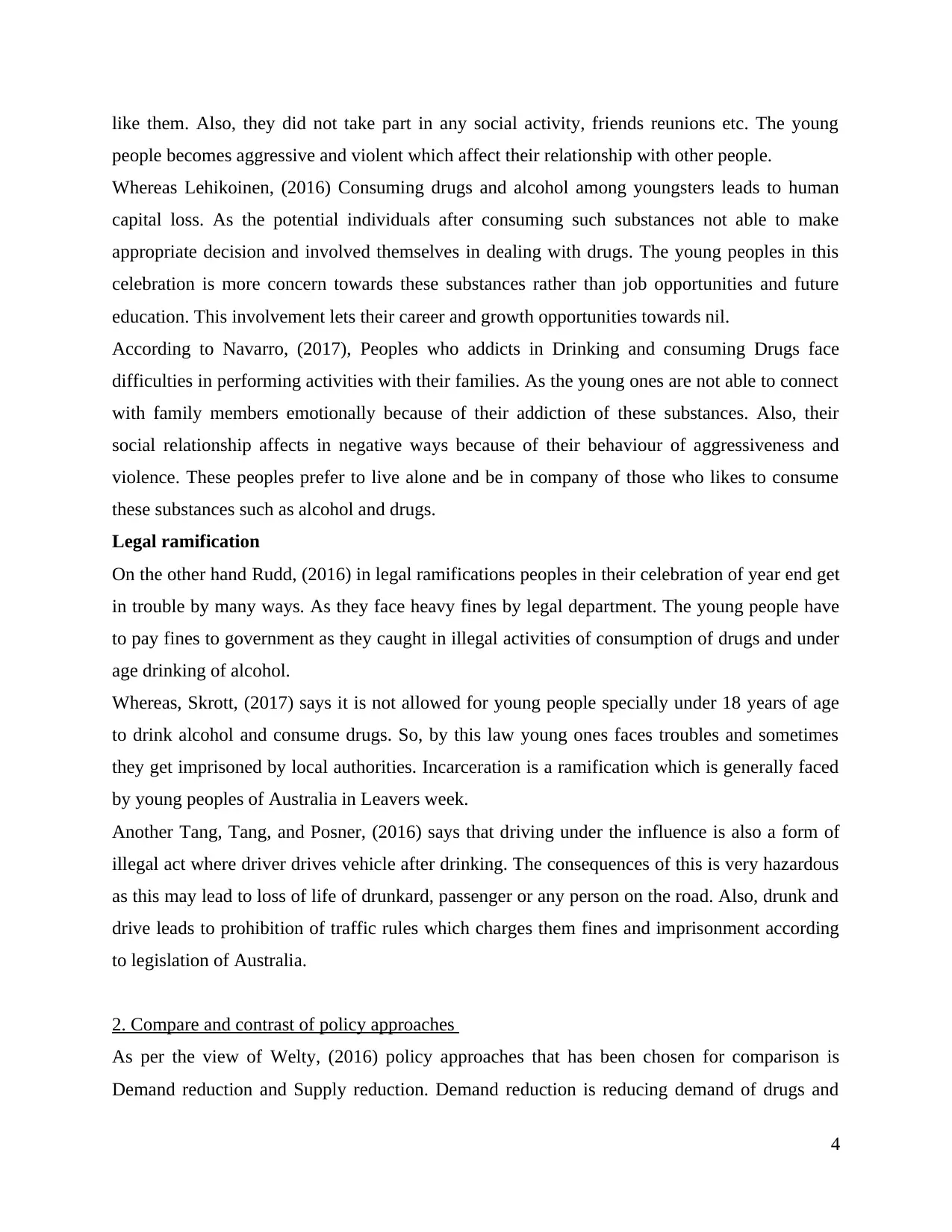
like them. Also, they did not take part in any social activity, friends reunions etc. The young
people becomes aggressive and violent which affect their relationship with other people.
Whereas Lehikoinen, (2016) Consuming drugs and alcohol among youngsters leads to human
capital loss. As the potential individuals after consuming such substances not able to make
appropriate decision and involved themselves in dealing with drugs. The young peoples in this
celebration is more concern towards these substances rather than job opportunities and future
education. This involvement lets their career and growth opportunities towards nil.
According to Navarro, (2017), Peoples who addicts in Drinking and consuming Drugs face
difficulties in performing activities with their families. As the young ones are not able to connect
with family members emotionally because of their addiction of these substances. Also, their
social relationship affects in negative ways because of their behaviour of aggressiveness and
violence. These peoples prefer to live alone and be in company of those who likes to consume
these substances such as alcohol and drugs.
Legal ramification
On the other hand Rudd, (2016) in legal ramifications peoples in their celebration of year end get
in trouble by many ways. As they face heavy fines by legal department. The young people have
to pay fines to government as they caught in illegal activities of consumption of drugs and under
age drinking of alcohol.
Whereas, Skrott, (2017) says it is not allowed for young people specially under 18 years of age
to drink alcohol and consume drugs. So, by this law young ones faces troubles and sometimes
they get imprisoned by local authorities. Incarceration is a ramification which is generally faced
by young peoples of Australia in Leavers week.
Another Tang, Tang, and Posner, (2016) says that driving under the influence is also a form of
illegal act where driver drives vehicle after drinking. The consequences of this is very hazardous
as this may lead to loss of life of drunkard, passenger or any person on the road. Also, drunk and
drive leads to prohibition of traffic rules which charges them fines and imprisonment according
to legislation of Australia.
2. Compare and contrast of policy approaches
As per the view of Welty, (2016) policy approaches that has been chosen for comparison is
Demand reduction and Supply reduction. Demand reduction is reducing demand of drugs and
4
people becomes aggressive and violent which affect their relationship with other people.
Whereas Lehikoinen, (2016) Consuming drugs and alcohol among youngsters leads to human
capital loss. As the potential individuals after consuming such substances not able to make
appropriate decision and involved themselves in dealing with drugs. The young peoples in this
celebration is more concern towards these substances rather than job opportunities and future
education. This involvement lets their career and growth opportunities towards nil.
According to Navarro, (2017), Peoples who addicts in Drinking and consuming Drugs face
difficulties in performing activities with their families. As the young ones are not able to connect
with family members emotionally because of their addiction of these substances. Also, their
social relationship affects in negative ways because of their behaviour of aggressiveness and
violence. These peoples prefer to live alone and be in company of those who likes to consume
these substances such as alcohol and drugs.
Legal ramification
On the other hand Rudd, (2016) in legal ramifications peoples in their celebration of year end get
in trouble by many ways. As they face heavy fines by legal department. The young people have
to pay fines to government as they caught in illegal activities of consumption of drugs and under
age drinking of alcohol.
Whereas, Skrott, (2017) says it is not allowed for young people specially under 18 years of age
to drink alcohol and consume drugs. So, by this law young ones faces troubles and sometimes
they get imprisoned by local authorities. Incarceration is a ramification which is generally faced
by young peoples of Australia in Leavers week.
Another Tang, Tang, and Posner, (2016) says that driving under the influence is also a form of
illegal act where driver drives vehicle after drinking. The consequences of this is very hazardous
as this may lead to loss of life of drunkard, passenger or any person on the road. Also, drunk and
drive leads to prohibition of traffic rules which charges them fines and imprisonment according
to legislation of Australia.
2. Compare and contrast of policy approaches
As per the view of Welty, (2016) policy approaches that has been chosen for comparison is
Demand reduction and Supply reduction. Demand reduction is reducing demand of drugs and
4
Paraphrase This Document
Need a fresh take? Get an instant paraphrase of this document with our AI Paraphraser
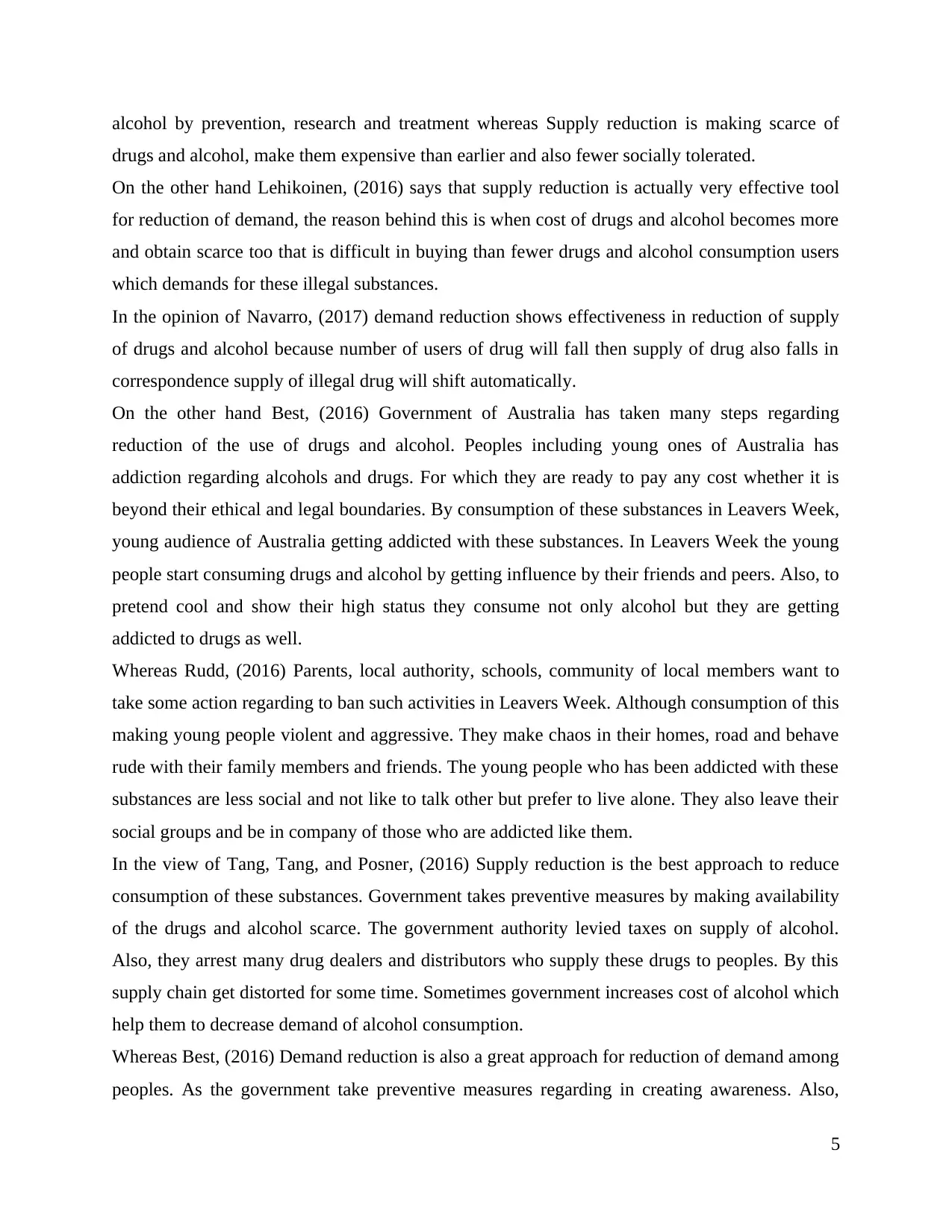
alcohol by prevention, research and treatment whereas Supply reduction is making scarce of
drugs and alcohol, make them expensive than earlier and also fewer socially tolerated.
On the other hand Lehikoinen, (2016) says that supply reduction is actually very effective tool
for reduction of demand, the reason behind this is when cost of drugs and alcohol becomes more
and obtain scarce too that is difficult in buying than fewer drugs and alcohol consumption users
which demands for these illegal substances.
In the opinion of Navarro, (2017) demand reduction shows effectiveness in reduction of supply
of drugs and alcohol because number of users of drug will fall then supply of drug also falls in
correspondence supply of illegal drug will shift automatically.
On the other hand Best, (2016) Government of Australia has taken many steps regarding
reduction of the use of drugs and alcohol. Peoples including young ones of Australia has
addiction regarding alcohols and drugs. For which they are ready to pay any cost whether it is
beyond their ethical and legal boundaries. By consumption of these substances in Leavers Week,
young audience of Australia getting addicted with these substances. In Leavers Week the young
people start consuming drugs and alcohol by getting influence by their friends and peers. Also, to
pretend cool and show their high status they consume not only alcohol but they are getting
addicted to drugs as well.
Whereas Rudd, (2016) Parents, local authority, schools, community of local members want to
take some action regarding to ban such activities in Leavers Week. Although consumption of this
making young people violent and aggressive. They make chaos in their homes, road and behave
rude with their family members and friends. The young people who has been addicted with these
substances are less social and not like to talk other but prefer to live alone. They also leave their
social groups and be in company of those who are addicted like them.
In the view of Tang, Tang, and Posner, (2016) Supply reduction is the best approach to reduce
consumption of these substances. Government takes preventive measures by making availability
of the drugs and alcohol scarce. The government authority levied taxes on supply of alcohol.
Also, they arrest many drug dealers and distributors who supply these drugs to peoples. By this
supply chain get distorted for some time. Sometimes government increases cost of alcohol which
help them to decrease demand of alcohol consumption.
Whereas Best, (2016) Demand reduction is also a great approach for reduction of demand among
peoples. As the government take preventive measures regarding in creating awareness. Also,
5
drugs and alcohol, make them expensive than earlier and also fewer socially tolerated.
On the other hand Lehikoinen, (2016) says that supply reduction is actually very effective tool
for reduction of demand, the reason behind this is when cost of drugs and alcohol becomes more
and obtain scarce too that is difficult in buying than fewer drugs and alcohol consumption users
which demands for these illegal substances.
In the opinion of Navarro, (2017) demand reduction shows effectiveness in reduction of supply
of drugs and alcohol because number of users of drug will fall then supply of drug also falls in
correspondence supply of illegal drug will shift automatically.
On the other hand Best, (2016) Government of Australia has taken many steps regarding
reduction of the use of drugs and alcohol. Peoples including young ones of Australia has
addiction regarding alcohols and drugs. For which they are ready to pay any cost whether it is
beyond their ethical and legal boundaries. By consumption of these substances in Leavers Week,
young audience of Australia getting addicted with these substances. In Leavers Week the young
people start consuming drugs and alcohol by getting influence by their friends and peers. Also, to
pretend cool and show their high status they consume not only alcohol but they are getting
addicted to drugs as well.
Whereas Rudd, (2016) Parents, local authority, schools, community of local members want to
take some action regarding to ban such activities in Leavers Week. Although consumption of this
making young people violent and aggressive. They make chaos in their homes, road and behave
rude with their family members and friends. The young people who has been addicted with these
substances are less social and not like to talk other but prefer to live alone. They also leave their
social groups and be in company of those who are addicted like them.
In the view of Tang, Tang, and Posner, (2016) Supply reduction is the best approach to reduce
consumption of these substances. Government takes preventive measures by making availability
of the drugs and alcohol scarce. The government authority levied taxes on supply of alcohol.
Also, they arrest many drug dealers and distributors who supply these drugs to peoples. By this
supply chain get distorted for some time. Sometimes government increases cost of alcohol which
help them to decrease demand of alcohol consumption.
Whereas Best, (2016) Demand reduction is also a great approach for reduction of demand among
peoples. As the government take preventive measures regarding in creating awareness. Also,
5
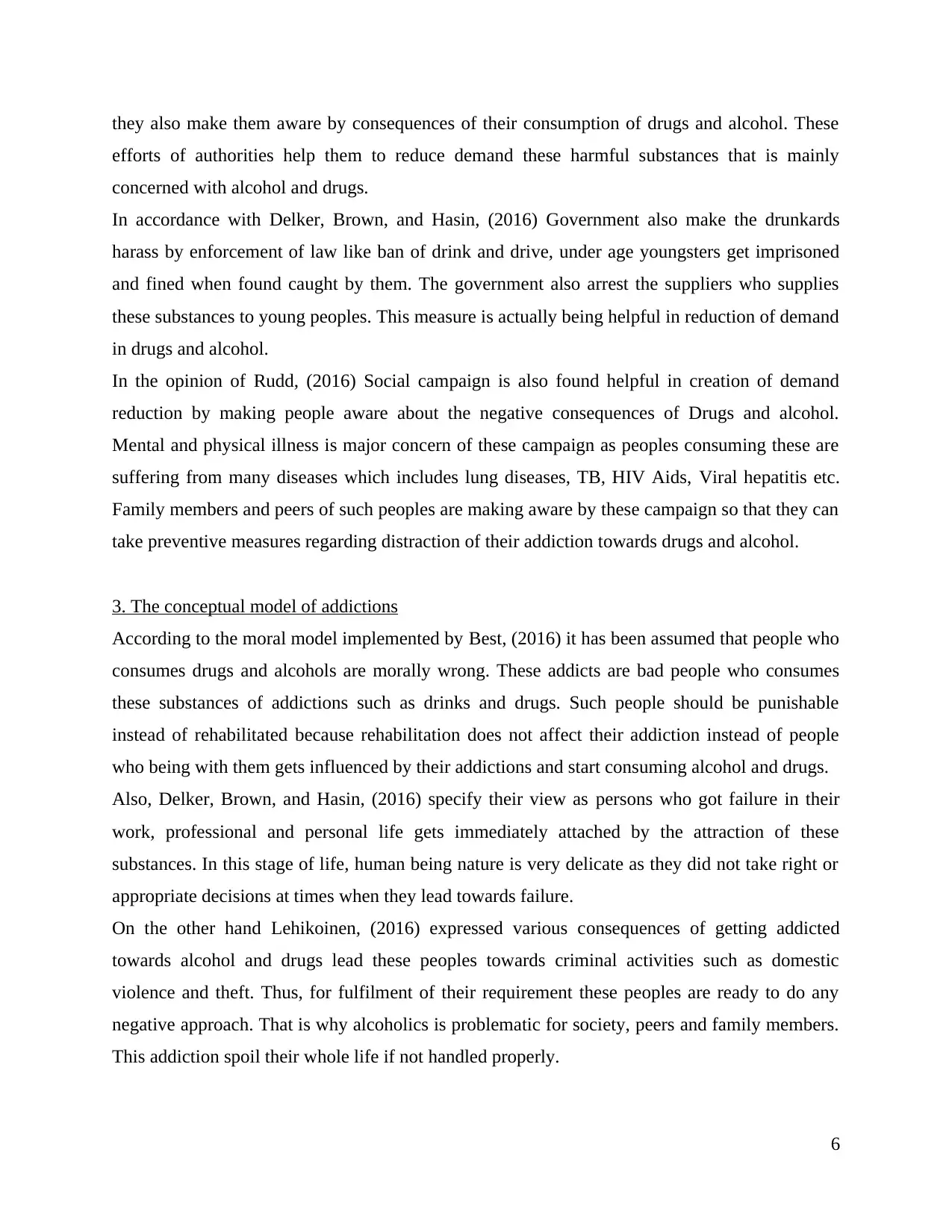
they also make them aware by consequences of their consumption of drugs and alcohol. These
efforts of authorities help them to reduce demand these harmful substances that is mainly
concerned with alcohol and drugs.
In accordance with Delker, Brown, and Hasin, (2016) Government also make the drunkards
harass by enforcement of law like ban of drink and drive, under age youngsters get imprisoned
and fined when found caught by them. The government also arrest the suppliers who supplies
these substances to young peoples. This measure is actually being helpful in reduction of demand
in drugs and alcohol.
In the opinion of Rudd, (2016) Social campaign is also found helpful in creation of demand
reduction by making people aware about the negative consequences of Drugs and alcohol.
Mental and physical illness is major concern of these campaign as peoples consuming these are
suffering from many diseases which includes lung diseases, TB, HIV Aids, Viral hepatitis etc.
Family members and peers of such peoples are making aware by these campaign so that they can
take preventive measures regarding distraction of their addiction towards drugs and alcohol.
3. The conceptual model of addictions
According to the moral model implemented by Best, (2016) it has been assumed that people who
consumes drugs and alcohols are morally wrong. These addicts are bad people who consumes
these substances of addictions such as drinks and drugs. Such people should be punishable
instead of rehabilitated because rehabilitation does not affect their addiction instead of people
who being with them gets influenced by their addictions and start consuming alcohol and drugs.
Also, Delker, Brown, and Hasin, (2016) specify their view as persons who got failure in their
work, professional and personal life gets immediately attached by the attraction of these
substances. In this stage of life, human being nature is very delicate as they did not take right or
appropriate decisions at times when they lead towards failure.
On the other hand Lehikoinen, (2016) expressed various consequences of getting addicted
towards alcohol and drugs lead these peoples towards criminal activities such as domestic
violence and theft. Thus, for fulfilment of their requirement these peoples are ready to do any
negative approach. That is why alcoholics is problematic for society, peers and family members.
This addiction spoil their whole life if not handled properly.
6
efforts of authorities help them to reduce demand these harmful substances that is mainly
concerned with alcohol and drugs.
In accordance with Delker, Brown, and Hasin, (2016) Government also make the drunkards
harass by enforcement of law like ban of drink and drive, under age youngsters get imprisoned
and fined when found caught by them. The government also arrest the suppliers who supplies
these substances to young peoples. This measure is actually being helpful in reduction of demand
in drugs and alcohol.
In the opinion of Rudd, (2016) Social campaign is also found helpful in creation of demand
reduction by making people aware about the negative consequences of Drugs and alcohol.
Mental and physical illness is major concern of these campaign as peoples consuming these are
suffering from many diseases which includes lung diseases, TB, HIV Aids, Viral hepatitis etc.
Family members and peers of such peoples are making aware by these campaign so that they can
take preventive measures regarding distraction of their addiction towards drugs and alcohol.
3. The conceptual model of addictions
According to the moral model implemented by Best, (2016) it has been assumed that people who
consumes drugs and alcohols are morally wrong. These addicts are bad people who consumes
these substances of addictions such as drinks and drugs. Such people should be punishable
instead of rehabilitated because rehabilitation does not affect their addiction instead of people
who being with them gets influenced by their addictions and start consuming alcohol and drugs.
Also, Delker, Brown, and Hasin, (2016) specify their view as persons who got failure in their
work, professional and personal life gets immediately attached by the attraction of these
substances. In this stage of life, human being nature is very delicate as they did not take right or
appropriate decisions at times when they lead towards failure.
On the other hand Lehikoinen, (2016) expressed various consequences of getting addicted
towards alcohol and drugs lead these peoples towards criminal activities such as domestic
violence and theft. Thus, for fulfilment of their requirement these peoples are ready to do any
negative approach. That is why alcoholics is problematic for society, peers and family members.
This addiction spoil their whole life if not handled properly.
6
⊘ This is a preview!⊘
Do you want full access?
Subscribe today to unlock all pages.

Trusted by 1+ million students worldwide
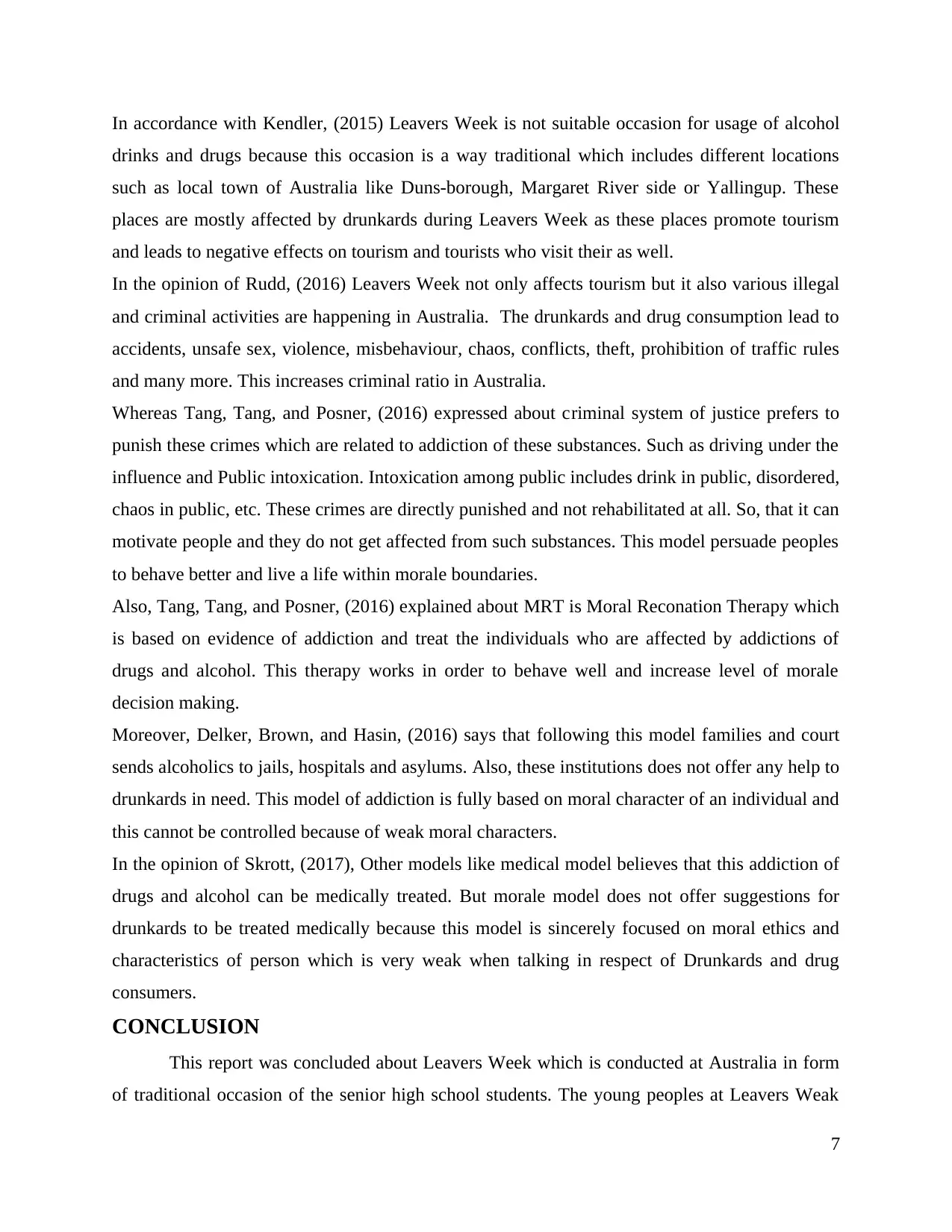
In accordance with Kendler, (2015) Leavers Week is not suitable occasion for usage of alcohol
drinks and drugs because this occasion is a way traditional which includes different locations
such as local town of Australia like Duns-borough, Margaret River side or Yallingup. These
places are mostly affected by drunkards during Leavers Week as these places promote tourism
and leads to negative effects on tourism and tourists who visit their as well.
In the opinion of Rudd, (2016) Leavers Week not only affects tourism but it also various illegal
and criminal activities are happening in Australia. The drunkards and drug consumption lead to
accidents, unsafe sex, violence, misbehaviour, chaos, conflicts, theft, prohibition of traffic rules
and many more. This increases criminal ratio in Australia.
Whereas Tang, Tang, and Posner, (2016) expressed about criminal system of justice prefers to
punish these crimes which are related to addiction of these substances. Such as driving under the
influence and Public intoxication. Intoxication among public includes drink in public, disordered,
chaos in public, etc. These crimes are directly punished and not rehabilitated at all. So, that it can
motivate people and they do not get affected from such substances. This model persuade peoples
to behave better and live a life within morale boundaries.
Also, Tang, Tang, and Posner, (2016) explained about MRT is Moral Reconation Therapy which
is based on evidence of addiction and treat the individuals who are affected by addictions of
drugs and alcohol. This therapy works in order to behave well and increase level of morale
decision making.
Moreover, Delker, Brown, and Hasin, (2016) says that following this model families and court
sends alcoholics to jails, hospitals and asylums. Also, these institutions does not offer any help to
drunkards in need. This model of addiction is fully based on moral character of an individual and
this cannot be controlled because of weak moral characters.
In the opinion of Skrott, (2017), Other models like medical model believes that this addiction of
drugs and alcohol can be medically treated. But morale model does not offer suggestions for
drunkards to be treated medically because this model is sincerely focused on moral ethics and
characteristics of person which is very weak when talking in respect of Drunkards and drug
consumers.
CONCLUSION
This report was concluded about Leavers Week which is conducted at Australia in form
of traditional occasion of the senior high school students. The young peoples at Leavers Weak
7
drinks and drugs because this occasion is a way traditional which includes different locations
such as local town of Australia like Duns-borough, Margaret River side or Yallingup. These
places are mostly affected by drunkards during Leavers Week as these places promote tourism
and leads to negative effects on tourism and tourists who visit their as well.
In the opinion of Rudd, (2016) Leavers Week not only affects tourism but it also various illegal
and criminal activities are happening in Australia. The drunkards and drug consumption lead to
accidents, unsafe sex, violence, misbehaviour, chaos, conflicts, theft, prohibition of traffic rules
and many more. This increases criminal ratio in Australia.
Whereas Tang, Tang, and Posner, (2016) expressed about criminal system of justice prefers to
punish these crimes which are related to addiction of these substances. Such as driving under the
influence and Public intoxication. Intoxication among public includes drink in public, disordered,
chaos in public, etc. These crimes are directly punished and not rehabilitated at all. So, that it can
motivate people and they do not get affected from such substances. This model persuade peoples
to behave better and live a life within morale boundaries.
Also, Tang, Tang, and Posner, (2016) explained about MRT is Moral Reconation Therapy which
is based on evidence of addiction and treat the individuals who are affected by addictions of
drugs and alcohol. This therapy works in order to behave well and increase level of morale
decision making.
Moreover, Delker, Brown, and Hasin, (2016) says that following this model families and court
sends alcoholics to jails, hospitals and asylums. Also, these institutions does not offer any help to
drunkards in need. This model of addiction is fully based on moral character of an individual and
this cannot be controlled because of weak moral characters.
In the opinion of Skrott, (2017), Other models like medical model believes that this addiction of
drugs and alcohol can be medically treated. But morale model does not offer suggestions for
drunkards to be treated medically because this model is sincerely focused on moral ethics and
characteristics of person which is very weak when talking in respect of Drunkards and drug
consumers.
CONCLUSION
This report was concluded about Leavers Week which is conducted at Australia in form
of traditional occasion of the senior high school students. The young peoples at Leavers Weak
7
Paraphrase This Document
Need a fresh take? Get an instant paraphrase of this document with our AI Paraphraser
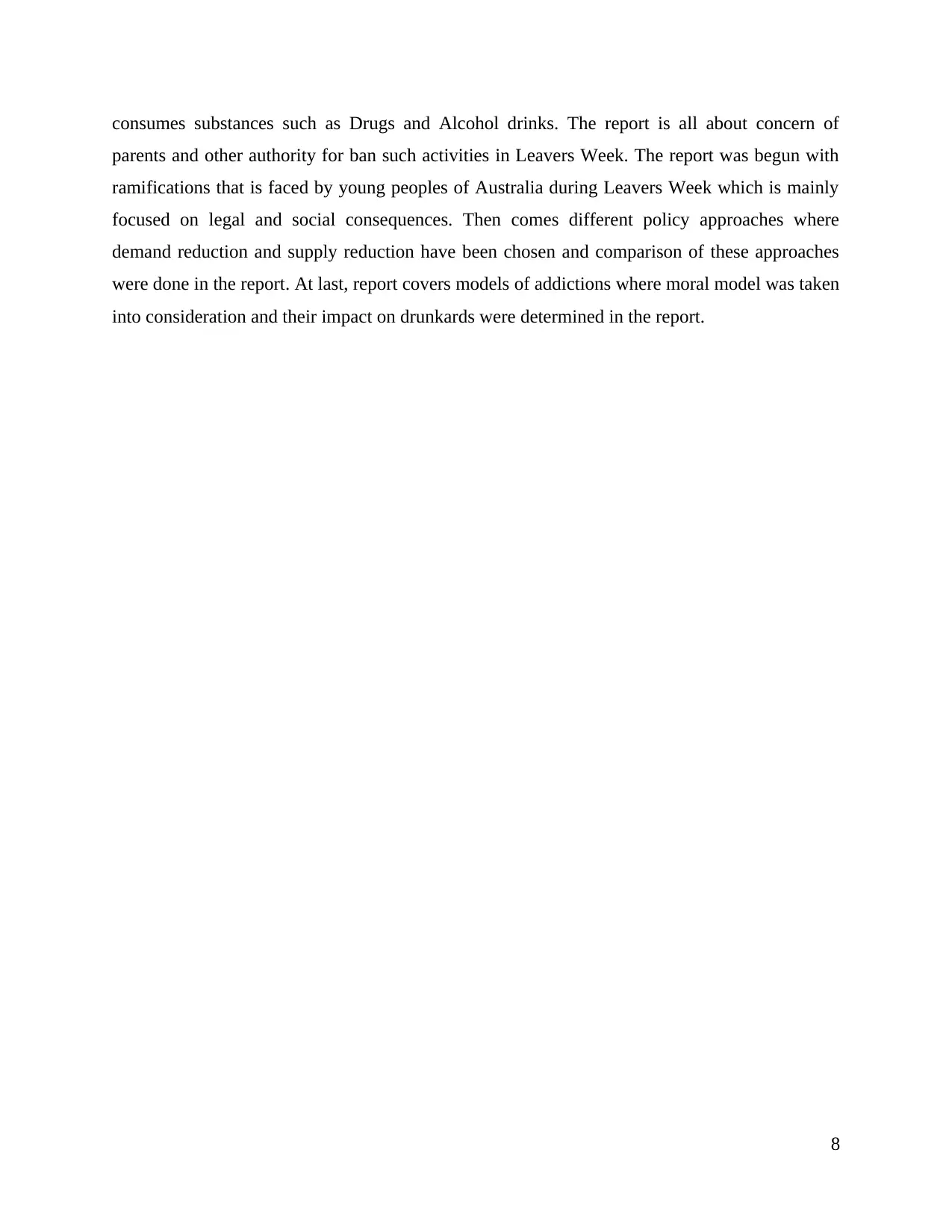
consumes substances such as Drugs and Alcohol drinks. The report is all about concern of
parents and other authority for ban such activities in Leavers Week. The report was begun with
ramifications that is faced by young peoples of Australia during Leavers Week which is mainly
focused on legal and social consequences. Then comes different policy approaches where
demand reduction and supply reduction have been chosen and comparison of these approaches
were done in the report. At last, report covers models of addictions where moral model was taken
into consideration and their impact on drunkards were determined in the report.
8
parents and other authority for ban such activities in Leavers Week. The report was begun with
ramifications that is faced by young peoples of Australia during Leavers Week which is mainly
focused on legal and social consequences. Then comes different policy approaches where
demand reduction and supply reduction have been chosen and comparison of these approaches
were done in the report. At last, report covers models of addictions where moral model was taken
into consideration and their impact on drunkards were determined in the report.
8

REFERENCES
Books and Journals
Best, D. and et.al., 2016. Overcoming alcohol and other drug addiction as a process of social
identity transition: The social identity model of recovery (SIMOR). Addiction Research
& Theory.24(2).pp.111-123.
Delker, E., Brown, Q. and Hasin, D.S., 2016. Alcohol consumption in demographic
subpopulations: an epidemiologic overview. Alcohol research: current reviews.38(1).p.7.
Hoggatt, K. J. and et.al., 2015. Alcohol and drug misuse, abuse, and dependence in women
veterans. Epidemiologic reviews. 37(1).pp.23-37.
Kendler, K. S. and et.al., 2015. Triparental families: a new genetic-epidemiological design
applied to drug abuse, alcohol use disorders, and criminal behavior in a Swedish national
sample. American Journal of Psychiatry.172(6).pp.553-560.
Lehikoinen, A. and et.al., 2016. Maternal drug or alcohol abuse is associated with decreased
head size from mid‐pregnancy to childhood. Acta Paediatrica. 105(7). pp.817-822.
Navarro, M., 2017. The Role of the Melanocortin System in Drug and Alcohol Abuse. In
International review of neurobiology (Vol. 136, pp. 121-150). Academic Press.
Rudd, R. A. and et.al., 2016. Increases in drug and opioid overdose deaths—United States,
2000–2014. American Journal of Transplantation.16(4). pp.1323-1327.
Skrott, Z. and et.al., 2017. Alcohol-abuse drug disulfiram targets cancer via p97 segregase
adaptor NPL4. Nature.552(7684).p.194.
Tang, Y. Y., Tang, R. and Posner, M. I., 2016. Mindfulness meditation improves emotion
regulation and reduces drug abuse. Drug and Alcohol Dependence.163.pp.S13-S18.
Welty, L. J. and et.al., 2016. Health disparities in drug-and alcohol-use disorders: A 12-year
longitudinal study of youths after detention. American journal of public
health.106(5).pp.872-880.
Online
Moral model of addiction. 2019. [Online]. Available through.
<https://www.promises.com/blog/moving-beyond-the-moral-model-of-addiction/>.
9
Books and Journals
Best, D. and et.al., 2016. Overcoming alcohol and other drug addiction as a process of social
identity transition: The social identity model of recovery (SIMOR). Addiction Research
& Theory.24(2).pp.111-123.
Delker, E., Brown, Q. and Hasin, D.S., 2016. Alcohol consumption in demographic
subpopulations: an epidemiologic overview. Alcohol research: current reviews.38(1).p.7.
Hoggatt, K. J. and et.al., 2015. Alcohol and drug misuse, abuse, and dependence in women
veterans. Epidemiologic reviews. 37(1).pp.23-37.
Kendler, K. S. and et.al., 2015. Triparental families: a new genetic-epidemiological design
applied to drug abuse, alcohol use disorders, and criminal behavior in a Swedish national
sample. American Journal of Psychiatry.172(6).pp.553-560.
Lehikoinen, A. and et.al., 2016. Maternal drug or alcohol abuse is associated with decreased
head size from mid‐pregnancy to childhood. Acta Paediatrica. 105(7). pp.817-822.
Navarro, M., 2017. The Role of the Melanocortin System in Drug and Alcohol Abuse. In
International review of neurobiology (Vol. 136, pp. 121-150). Academic Press.
Rudd, R. A. and et.al., 2016. Increases in drug and opioid overdose deaths—United States,
2000–2014. American Journal of Transplantation.16(4). pp.1323-1327.
Skrott, Z. and et.al., 2017. Alcohol-abuse drug disulfiram targets cancer via p97 segregase
adaptor NPL4. Nature.552(7684).p.194.
Tang, Y. Y., Tang, R. and Posner, M. I., 2016. Mindfulness meditation improves emotion
regulation and reduces drug abuse. Drug and Alcohol Dependence.163.pp.S13-S18.
Welty, L. J. and et.al., 2016. Health disparities in drug-and alcohol-use disorders: A 12-year
longitudinal study of youths after detention. American journal of public
health.106(5).pp.872-880.
Online
Moral model of addiction. 2019. [Online]. Available through.
<https://www.promises.com/blog/moving-beyond-the-moral-model-of-addiction/>.
9
⊘ This is a preview!⊘
Do you want full access?
Subscribe today to unlock all pages.

Trusted by 1+ million students worldwide
1 out of 9
Related Documents
Your All-in-One AI-Powered Toolkit for Academic Success.
+13062052269
info@desklib.com
Available 24*7 on WhatsApp / Email
![[object Object]](/_next/static/media/star-bottom.7253800d.svg)
Unlock your academic potential
Copyright © 2020–2025 A2Z Services. All Rights Reserved. Developed and managed by ZUCOL.





